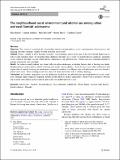Files in this item
The neighbourhood social environment and alcohol use among urban and rural Scottish adolescents
Item metadata
| dc.contributor.author | Martin, Gina | |
| dc.contributor.author | Inchley, Joanna | |
| dc.contributor.author | Marshall, Alan | |
| dc.contributor.author | Shortt, Niamh | |
| dc.contributor.author | Currie, Candace | |
| dc.date.accessioned | 2018-12-10T13:30:05Z | |
| dc.date.available | 2018-12-10T13:30:05Z | |
| dc.date.issued | 2019-01 | |
| dc.identifier | 256632004 | |
| dc.identifier | ef164eb4-a5a6-498c-a1da-0b31c41086e7 | |
| dc.identifier | 85058036663 | |
| dc.identifier | 000457744700013 | |
| dc.identifier.citation | Martin , G , Inchley , J , Marshall , A , Shortt , N & Currie , C 2019 , ' The neighbourhood social environment and alcohol use among urban and rural Scottish adolescents ' , International Journal of Public Health , vol. 64 , no. 1 , pp. 95-105 . https://doi.org/10.1007/s00038-018-1181-8 | en |
| dc.identifier.issn | 1661-8556 | |
| dc.identifier.other | ORCID: /0000-0001-8322-8817/work/65014245 | |
| dc.identifier.uri | https://hdl.handle.net/10023/16658 | |
| dc.description | Funding for the Scottish Health Behaviour in School-aged Children was provided by NHS Scotland. This work was also supported by the 600th Anniversary Ph.D. Scholarship which was awarded to Gina Martin by the University of St Andrews. | en |
| dc.description.abstract | Objectives This research examined the relationship between neighbourhood social environmental characteristics and drinking outcomes among a sample of urban and rural adolescents. Methods From a sample of 1558 Scottish secondary schoolchildren, surveyed as part of the 2010 Health Behaviour in School-aged Children study, we modelled three drinking outcomes on a variety of neighbourhood conditions, including social cohesion, disorder, alcohol outlet density, deprivation, and urban/rurality. Nested and cross-classified multilevel logistic regressions were specified. Results An urban-to-rural gradient was found with non-urban adolescents exhibiting higher odds of having ever drank. Neighbourhood social cohesion related to having ever drank. Among drinkers, those living in accessible small towns had higher odds of weekly drinking and drunkenness compared to urban areas. Higher odds of drunkenness were also found in remote rural areas. Those residing in the least deprived areas had lower odds of weekly drinking. Conclusions In Scotland, inequalities exist in adolescent alcohol use by urban/rurality and neighbourhood social conditions. Findings support regional targeting of public health efforts to address inequalities. Future work is needed to develop and evaluate intervention and prevention approaches for neighbourhoods at risk. | |
| dc.format.extent | 11 | |
| dc.format.extent | 473098 | |
| dc.language.iso | eng | |
| dc.relation.ispartof | International Journal of Public Health | en |
| dc.subject | Adolescents | en |
| dc.subject | Alcohol | en |
| dc.subject | Neighbourhood | en |
| dc.subject | Cross-classified | en |
| dc.subject | Multilevel | en |
| dc.subject | Urban | en |
| dc.subject | Rural | en |
| dc.subject | Alcohol outlet density | en |
| dc.subject | Social cohesion | en |
| dc.subject | Disorder | en |
| dc.subject | HT Communities. Classes. Races | en |
| dc.subject | RA0421 Public health. Hygiene. Preventive Medicine | en |
| dc.subject | 3rd-DAS | en |
| dc.subject | SDG 3 - Good Health and Well-being | en |
| dc.subject.lcc | HT | en |
| dc.subject.lcc | RA0421 | en |
| dc.title | The neighbourhood social environment and alcohol use among urban and rural Scottish adolescents | en |
| dc.type | Journal article | en |
| dc.contributor.institution | University of St Andrews. Population and Behavioural Science Division | en |
| dc.contributor.institution | University of St Andrews. School of Medicine | en |
| dc.contributor.institution | University of St Andrews. Child and Adolescent Health Research Unit | en |
| dc.contributor.institution | University of St Andrews. WHO Collaborating Centre for International Child & Adolescent Health Policy | en |
| dc.identifier.doi | https://doi.org/10.1007/s00038-018-1181-8 | |
| dc.description.status | Peer reviewed | en |
This item appears in the following Collection(s)
Items in the St Andrews Research Repository are protected by copyright, with all rights reserved, unless otherwise indicated.

